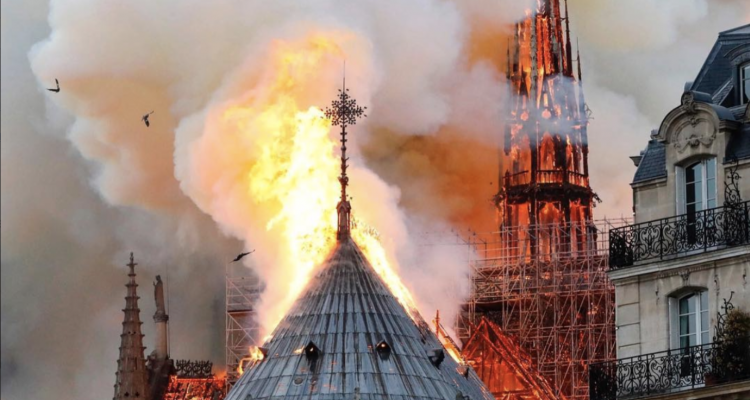For over six hundred years, Paris’ Notre Dame Cathedral has stood tall and strong over a small island in the middle of the Seine. It has inspired poems, songs and stories in dozens of different languages and been the destination of over 13 million visitors a year, many of whom have traveled thousands of miles to gaze at the gothic architecture, learn its history and pray before the religious artifacts it holds.
On Monday, April 15 at 6:30 p.m. CST, the world watched as the historical monument and religious masterpiece began to burn.
The fire burned for nine hours, the flames being declared “under control” at 2 a.m. Tuesday, April 16, though they continued to burn for several hours longer. Throughout the destruction, news stations provided live coverage and mourners across the globe began to converge, gathering to pray or offering hopes that some of the cathedral could be saved.
“When I heard and saw the news of a massive fire engulfing the Cathedral of Notre Dame, my hands started shaking and I didn’t know what to do with myself,” said Eileen Michaud ’20, a Fairfield University art history major currently studying abroad. “I felt as if it wouldn’t be right to immediately carry on with my life after hearing of the loss of a true icon of the city of Paris and of the Catholic faith.”
Firefighters arrived on the scene almost immediately and began to work to save the Cathedral. Recent reports show that, while the famed spire fell, Notre Dame’s two towers were saved, as were many major art pieces and sacred items. These include the Crown of Thorns, the statues of the apostles around the spire (which had been removed before the collapse due to renovation), and the Tunic of Saint Louis. On April 16, further reports announced that the Cathedral’s rose windows and the famed “May de Notre-Dame” are also safe.
News of the Crown of Thorns was a special relief for many as this fire occurred during Holy Week and Catholics worldwide prepare for Easter on Sunday, April 20. Every Easter, thousands turn their eyes to Notre Dame as the Cathedral displays the Crown of Thorns, believed to be the crown worn by Jesus when he was crucified, as well as a piece of wood and a nail believed to have been part of the cross.
“I’ve read some articles which point out that the overall shape of the cathedral is cruciform – in the shape of a large cross,” said Rev. Mark P. Scalese, S.J., director of campus ministry, who has visited Notre Dame twice and fondly remembers the Cathedrals rose windows and the warm glow of the vocative prayer candles.
“And of course the name of the cathedral itself means ‘Our Lady,’ referring to the Blessed Mother of Jesus. During this Holy Week, we’re reminded of the story of Our Lady standing at the foot of the cross as Jesus died, weeping. It’s a holy irony that so many people in Paris stood looking up with tears in their eyes at the cathedral’s roof as it burned.”
However, the spire was not the only segment of the Cathedral to fall. The famed roof structure, which dates back to construction during the 13th century (the Cathedral took nearly 200 years to build and the roof was made early on) and was known as “the forest” due to the amount of trees used to build and maintain, was also lost to the flames.
While parts of the Cathedral were saved and the French government has already announced they will re-erect and reconstruct the structure, it is a resounding consensus that Notre Dame will never be the same and this event is a historical tragedy.
“Each of us at Fairfield -students, faculty and alumni- has lost a small fragment of immeasurably intangible value with the destructive fire at Notre Dame,” said Philip Eliasoph, Ph.D., a professor of Art History.
“This remarkable monument in the medieval core of Paris is a testament to humanity’s most noble aspirations of faith, creativity, and architectural vision. Beyond its universal acclaim as a monument of ravishing beauty, it affirms the symbolic meaning of this Passover/Easter season by inspiring us to find light from darkness and freedom from slavery. Our hearts ache for our Parisian brothers and sisters who will have to harness their collective energies to re-erect its spire as a beacon of hope for The City of Light.”


Leave a Reply